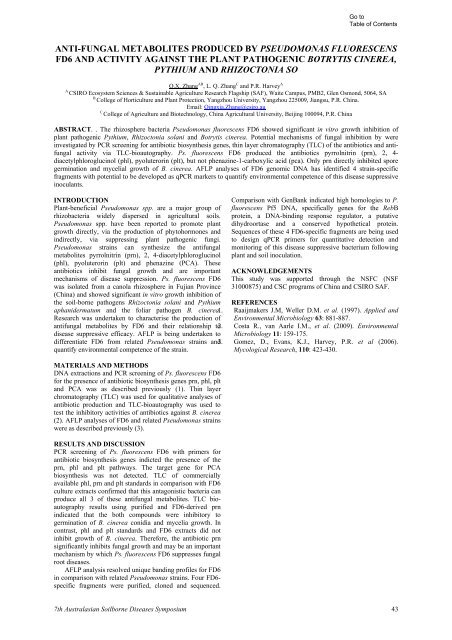invit - Australasian Plant Pathology Society
invit - Australasian Plant Pathology Society
invit - Australasian Plant Pathology Society
You also want an ePaper? Increase the reach of your titles
YUMPU automatically turns print PDFs into web optimized ePapers that Google loves.
Go to<br />
Table of Contents<br />
ANTI-FUNGAL METABOLITES PRODUCED BY PSEUDOMONAS FLUORESCENS<br />
FD6 AND ACTIVITY AGAINST THE PLANT PATHOGENIC BOTRYTIS CINEREA,<br />
PYTHIUM AND RHIZOCTONIA SO<br />
Q.X. Zhang AB , L. Q. Zhang C and P.R. Harvey A<br />
A<br />
CSIRO Ecosystem Sciences & Sustainable Agriculture Research Flagship (SAF), Waite Campus, PMB2, Glen Osmond, 5064, SA<br />
B<br />
College of Horticulture and <strong>Plant</strong> Protection, Yangzhou University, Yangzhou 225009, Jiangsu, P.R. China.<br />
Email: Qingxia.Zhang@csiro.au<br />
C<br />
College of Agriculture and Biotechnology, China Agricultural University, Beijing 100094, P.R. China<br />
ABSTRACT. . The rhizosphere bacteria Pseudomonas fluorescens FD6 showed significant in vitro growth inhibition of<br />
plant pathogenic Pythium, Rhizoctonia solani and Botrytis cinerea. Potential mechanisms of fungal inhibition by were<br />
investigated by PCR screening for antibiotic biosynthesis genes, thin layer chromatography (TLC) of the antibiotics and antifungal<br />
activity via TLC-bioautography. Ps. fluorescens FD6 produced the antibiotics pyrrolnitrin (prn), 2, 4-<br />
diacetylphloroglucinol (phl), pyoluterorin (plt), but not phenazine-1-carboxylic acid (pca). Only prn directly inhibited spore<br />
germination and mycelial growth of B. cinerea. AFLP analyses of FD6 genomic DNA has identified 4 strain-specific<br />
fragments with potential to be developed as qPCR markers to quantify environmental competence of this disease suppressive<br />
inoculants.<br />
INTRODUCTION<br />
<strong>Plant</strong>-beneficial Pseudomonas spp. are a major group of<br />
rhizobacteria widely dispersed in agricultural soils.<br />
Pseudomonas spp. have been reported to promote plant<br />
growth directly, via the production of phytohormones and<br />
indirectly, via suppressing plant pathogenic fungi.<br />
Pseudomonas strains can synthesize the antifungal<br />
metabolites pyrrolnitrin (prn), 2, 4-diacetylphloroglucinol<br />
(phl), pyoluterorin (plt) and phenazine (PCA). These<br />
antibiotics inhibit fungal growth and are important<br />
mechanisms of disease suppression. Ps. fluorescens FD6<br />
was isolated from a canola rhizosphere in Fujian Province<br />
(China) and showed significant in vitro growth inhibition of<br />
the soil-borne pathogens Rhizoctonia solani and Pythium<br />
aphanidermatum and the foliar pathogen B. cinerea.<br />
Research was undertaken to characterise the production of<br />
antifungal metabolites by FD6 and their relationship to<br />
disease suppressive efficacy. AFLP is being undertaken to<br />
differentiate FD6 from related Pseudomonas strains and<br />
quantify environmental competence of the strain.<br />
MATERIALS AND METHODS<br />
DNA extractions and PCR screening of Ps. fluorescens FD6<br />
for the presence of antibiotic biosynthesis genes prn, phl, plt<br />
and PCA was as described previously (1). Thin layer<br />
chromatography (TLC) was used for qualitative analyses of<br />
antibiotic production and TLC-bioautography was used to<br />
test the inhibitory activities of antibiotics against B. cinerea<br />
(2). AFLP analyses of FD6 and related Pseudomonas strains<br />
were as described previously (3).<br />
RESULTS AND DISCUSSION<br />
PCR screening of Ps. fluorescens FD6 with primers for<br />
antibiotic biosynthesis genes indicted the presence of the<br />
prn, phl and plt pathways. The target gene for PCA<br />
biosynthesis was not detected. TLC of commercially<br />
available phl, prn and plt standards in comparison with FD6<br />
culture extracts confirmed that this antagonistic bacteria can<br />
produce all 3 of these antifungal metabolites. TLC bioautography<br />
results using purified and FD6-derived prn<br />
indicated that the both compounds were inhibitory to<br />
germination of B. cinerea conidia and mycelia growth. In<br />
contrast, phl and plt standards and FD6 extracts did not<br />
inhibit growth of B. cinerea. Therefore, the antibiotic prn<br />
significantly inhibits fungal growth and may be an important<br />
mechanism by which Ps. fluorescens FD6 suppresses fungal<br />
root diseases.<br />
AFLP analysis resolved unique banding profiles for FD6<br />
in comparison with related Pseudomonas strains. Four FD6-<br />
specific fragments were purified, cloned and sequenced.<br />
Comparison with GenBank indicated high homologies to P.<br />
fluorescens Pf5 DNA, specifically genes for the RebB<br />
protein, a DNA-binding response regulator, a putative<br />
dihydroortase and a conserved hypothetical protein.<br />
Sequences of these 4 FD6-specific fragments are being used<br />
to design qPCR primers for quantitative detection and<br />
monitoring of this disease suppressive bacterium following<br />
plant and soil inoculation.<br />
ACKNOWLEDGEMENTS<br />
This study was supported through the NSFC (NSF<br />
31000875) and CSC programs of China and CSIRO SAF.<br />
REFERENCES<br />
1. Raaijmakers J.M, Weller D.M. et al. (1997). Applied and<br />
Environmental Microbiology 63: 881-887.<br />
2. Costa R., van Aarle I.M., et al. (2009). Environmental<br />
Microbiology 11: 159-175.<br />
3. Gomez, D., Evans, K.J., Harvey, P.R. et al (2006).<br />
Mycological Research, 110: 423-430.<br />
7th <strong>Australasian</strong> Soilborne Diseases Symposium 43






![[Compatibility Mode].pdf](https://img.yumpu.com/27318716/1/190x135/compatibility-modepdf.jpg?quality=85)










